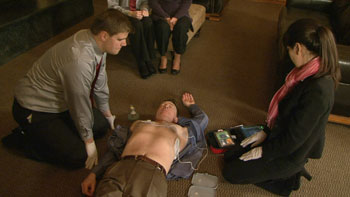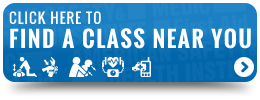 We’ve talked a lot in this blog about automated external defibrillators (AEDs) and how they make a life-and-death difference in incidents of sudden cardiac arrest (SCA). You can find AEDs in many public places, so you’ve no doubt walked past at least one at a mall, hotel, sports arena, or elsewhere.
We’ve talked a lot in this blog about automated external defibrillators (AEDs) and how they make a life-and-death difference in incidents of sudden cardiac arrest (SCA). You can find AEDs in many public places, so you’ve no doubt walked past at least one at a mall, hotel, sports arena, or elsewhere.
Most of us have also seen the AED in action in movies and on TV, with the patient’s chest and back arching dramatically off the ground as the device delivers a powerful shock. Often it’s that high-voltage image that’s in the back of someone’s mind when they see an AED, prompting many to say “no thanks” when it comes to being the bystander who actually pushes that button.
I recently came across a webpage with an excellent, straight-to-the-point overview of some common misconceptions about AEDs and what happens when you use them. A group of dedicated emergency care instructors in Scotland have organized a campaign to increase the prevalence of public AEDs there, and they offer the following list of misperceptions about these devices on their website AEDs in Scotland:
1. An AED can shock someone by accident.As the website explains, this is not so. An AED will only deliver a shock in the presence of certain heart rhythms.
2. AEDs are difficult to use & should only be used by professionals.
The AEDs you find in public were created for just that purpose – for use by the public, even if it's an untrained bystander.
3. When you shock someone they flail about and jump.
It makes for great TV, but it isn’t terribly realistic. As the website puts it: “When someone is shocked by an AED you may see a very slight shoulder shrug or a little movement, but their arms and legs will not shoot up. This is very important, as lay rescuers sometimes delay giving a shock to someone because of this perception.”
4. Fully automatic AEDs are dangerous.
A fully automatic AED completely bypasses that “point of no return” moment of button-pushing hesitation. Again, just as with the standard “push button” version, the device will not deliver the charge unless indicated by the heart rhythm of the patient.
5. We don't need AEDs, just call an ambulance.
While we are the first to praise our heroes in the EMS world for all the amazing things they do, we all know that sometimes, they just can’t get to the emergency scene fast enough. Remember, chances of survival drop 10% for every minute that passes before cardiac rhythm is restored. Every minute spent waiting for an ambulance counts and the sooner that AED is attached and readied, the better the victim’s chances.
Taking the mystery out of AEDs
One of the best ways to take the scary out of using an AED, as with so many things, is a good old-fashioned dose of practice. If you are an emergency care instructor teaching CPR, add an AED component to your classes. Our ASHI and MEDIC First Aid programs already include instructions on AED usage as a cognitive component of the classes. A hands-on session with an AED trainer unit is optional for our programs, but strongly encouraged. By employing such a training device in your classes, no matter what brand of CPR training you do, your students get a chance to practice applying the pads, clearing onlookers away from the patient, following the voice prompts of the unit, and pushing the button at the time indicated by the device.
Even if the training AED isn’t the one a bystander might ultimately use in an emergency, the act of practicing all the steps associated with using these devices can help build motor skills, increase retention, and reduce anxiety.
We’ll give the last word in today’s post to the organizers of the AED initiative in Scotland:
“There is anecdotal evidence that if a casualty does not survive having received a shock, the lay rescuer has a feeling of remorse because they applied the shock. The rescuer must remember that if the AED tells them to apply a shock, which the casualty needs, the shock cannot hurt them, it can only help them!”
Learn how shockingly easy it is to use an AED by taking a class today.








.png?width=600&name=HSI-CTA-EmergencyCareTraining%20(1).png)











Comments